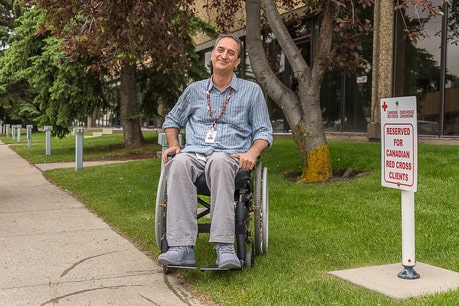Being ready for a disaster is important for everyone. And everyone putting together a preparedness kit should personalize it for their specific needs. This could be anything from including prescription medications to including an extra pair of eyeglasses.
If you are mobility impaired, there are certain items you should include in your personal preparedness kit.
 Mahmood Jafari, a Red Cross staff member who works with our Health Equipment Loan program, suffered a serious injury in Iran that left him in a wheelchair. As a member of the Red Cross family and a former soldier, Mahmood knows how important it is to take the time to be ready in case there is an emergency.
Mahmood Jafari, a Red Cross staff member who works with our Health Equipment Loan program, suffered a serious injury in Iran that left him in a wheelchair. As a member of the Red Cross family and a former soldier, Mahmood knows how important it is to take the time to be ready in case there is an emergency.He says his wheelchair is the most important thing and he has a spare one at home. He also has emergency contacts, who are aware of his specific needs and can be reached if something happens.
“The most important part of my emergency plan is to be prepared for any scenario,” Mahmood says. “This includes being stuck in my apartment for an extended period. I have back-up medications. I have back-ups for everything. It’s very hard to get medical supplies or equipment during an emergency.” He also recommends writing everything down in case your cell phone dies (passport number, prescriptions, emergency contacts).
When Mahmood was deployed to help with a Red Cross response, he was staying in a hotel that was wheelchair accessible. However, as someone with a spinal cord injury, he needs a specific bath chair that the room was not equipped with. In the future, he says he is going to take the time to ask for photos and take his shower chair with him if he can. “My brain is like you, my heart is like you, but I have specific needs. I will always take my bath chair with me when I stay somewhere new. Better to be safe than sorry. Being prepared gives me confidence.”
Here are some preparedness tips if you have impaired mobility.
- Have a primary and back up emergency contact.
- Create an evacuation plan. Make sure there is no furniture in the way. If you live in an apartment building, talk to the building manager. If your building has an elevator, make sure you have an alternative way to get out.
- Contact your local municipal office to ensure that the shelters in your area would be wheelchair accessible.
A couple of things to have ready if you are in a wheelchair:
- Tire patch kit
- Can of seal-in-air product (to repair flat tires on your wheelchair or scooter)
- Supply of inner tubes
- Pair of heavy gloves (to protect your hands while wheeling over glass or other sharp debris).
- Spare deep-cycle battery for a motorized wheelchair or scooter.
- A lightweight, manual wheelchair as a backup to a motorized wheelchair.
Related Stories:
Why have an emergency kit? One Fort McMurray resident's story
How to make an emergency kit for your car
Emergency preparedness: what's in your kit?

